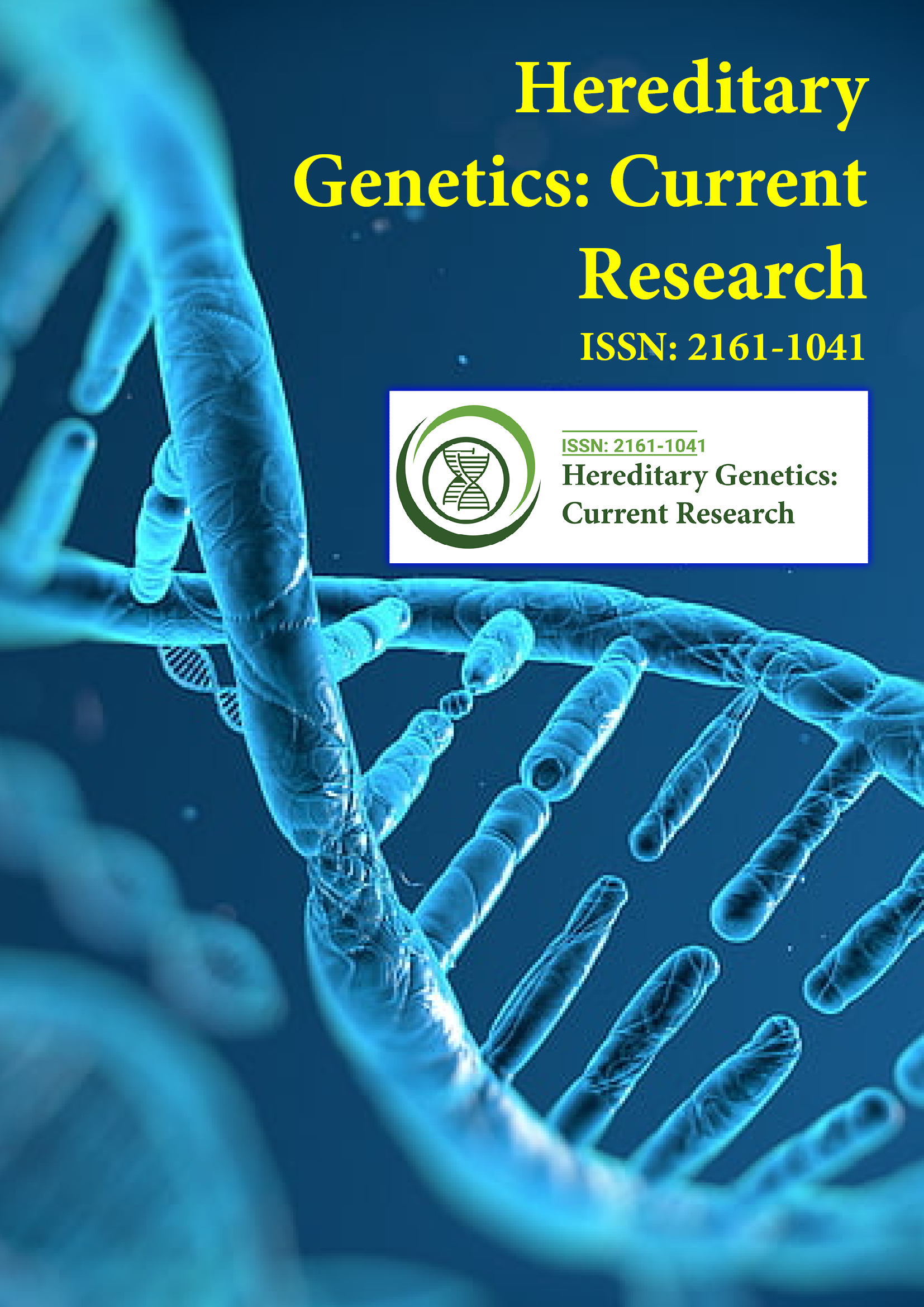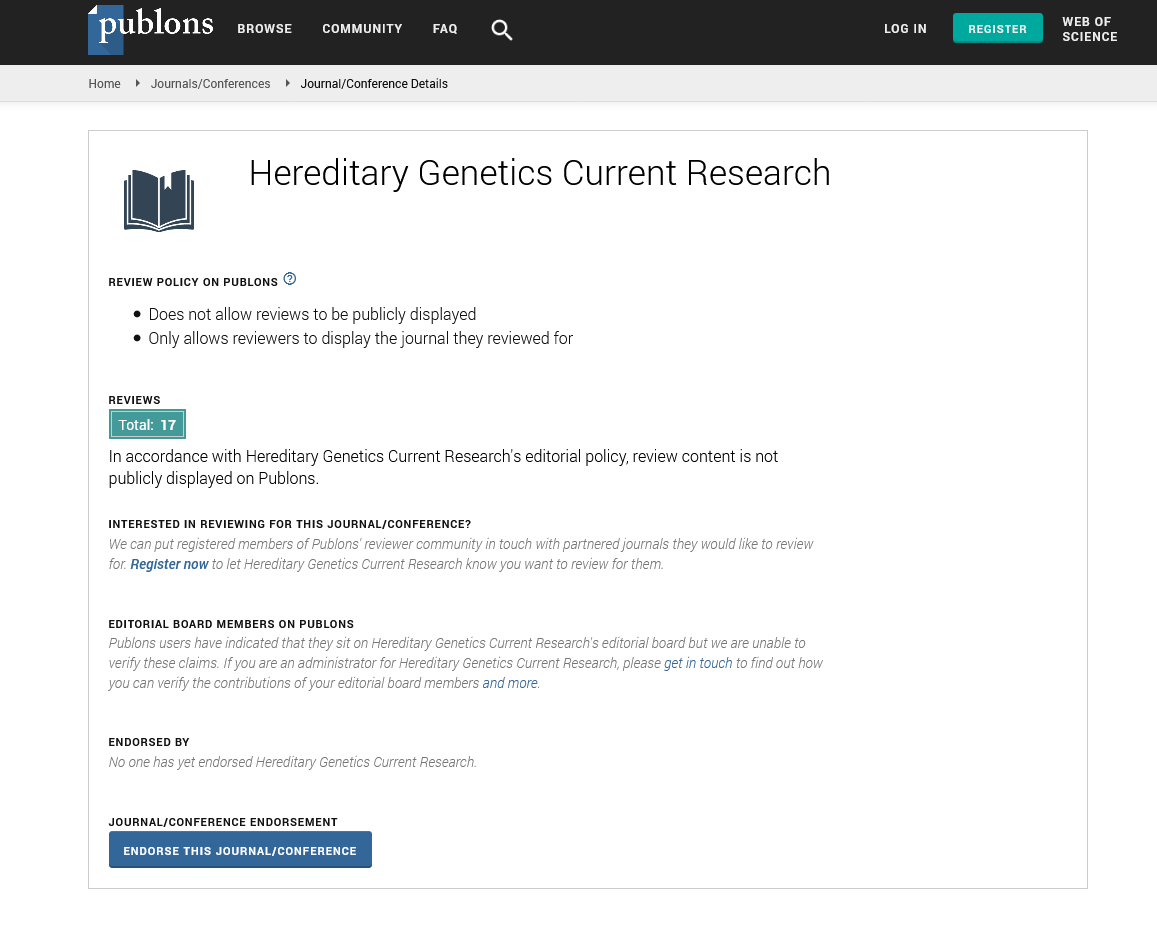Indexed In
- Open J Gate
- Genamics JournalSeek
- CiteFactor
- RefSeek
- Hamdard University
- EBSCO A-Z
- NSD - Norwegian Centre for Research Data
- OCLC- WorldCat
- Publons
- Geneva Foundation for Medical Education and Research
- Euro Pub
- Google Scholar
Useful Links
Share This Page
Journal Flyer

Open Access Journals
- Agri and Aquaculture
- Biochemistry
- Bioinformatics & Systems Biology
- Business & Management
- Chemistry
- Clinical Sciences
- Engineering
- Food & Nutrition
- General Science
- Genetics & Molecular Biology
- Immunology & Microbiology
- Medical Sciences
- Neuroscience & Psychology
- Nursing & Health Care
- Pharmaceutical Sciences
Perspective - (2023) Volume 12, Issue 3
Epigenetic Influences of Long Noncoding RNAs in Intrauterine Adhesion (IUA) and Cervical Cancer
Takako Hashimoto*Received: 01-Sep-2023, Manuscript No. HGCR-23-22978; Editor assigned: 04-Sep-2023, Pre QC No. HGCR-23-22978 (PQ); Reviewed: 18-Sep-2023, QC No. HGCR-23-22978 ; Revised: 25-Sep-2023, Manuscript No. HGCR-23-22978 (R); Published: 02-Oct-2023, DOI: 10.35248/2161-1041.23.12.254
Description
Long Noncoding RNAs (lncRNAs) have emerged as significant individuals in the regulation of various cellular processes and their role in the development and progression of diseases has collected considerable attention in recent years. Among the diverse array of diseases influenced by lncRNAs, two stand out due to their impact on women's health: Intrauterine Adhesion (IUA) and cervical cancer. Understanding the molecular mechanisms underlying these conditions is vital for advancing diagnostics, therapies, and preventive measures, potentially improving the lives of millions of women worldwide. IUA, commonly known as Asherman's Syndrome, is a gynecological disorder characterized by the formation of adhesions within the uterine cavity, often leading to infertility and menstrual abnormalities. These adhesions are primarily composed of fibrous tissues and can cause partial or complete removal of the uterine cavity. IUA is typically a consequence of endometrial injury, such as Dilation and Curettage (DandC), cesarean section, or uterine surgery. The clinical manifestations of IUA vary in severity and can include amenorrhea, hypomenorrhea, infertility, and recurrent pregnancy loss.
The severity of symptoms depends on the extent of adhesion formation within the uterine cavity. The pathogenesis of IUA is multifactorial and involves a complex interplay of molecular and cellular events. Endometrial injury disrupts the regenerative capacity of the endometrial lining, leading to impaired endometrial repair and fibrotic tissue formation. This process is regulated by various factors, including lncRNAs. LncRNAs are noncoding RNA molecules longer than 200 nucleotides that play critical roles in gene regulation at transcriptional, post- transcriptional and epigenetic levels. They can act as framework, guides, or induce for proteins and other nucleic acids, thereby modulating gene expression and cellular functions. Several lncRNAs have been identified as key players in IUA development and progression. H19 is a well-studied lncRNA that has been implicated in the pathogenesis of IUA. It is upregulated in the endometrial tissues of patients with IUA and promotes fibrosis by enhancing the expression of fibrosis-related genes, such as Collagen Type I Alpha 1 (COL1A1). H19 achieves this by serving as a molecular sponge for microRNAs (miRNAs) that would otherwise inhibit the expression of these fibrosis-related genes. In IUA, H19 sequesters miR-29b, which results in increased COL1A1 expression and collagen deposition within the uterine cavity. Metastasis-Associated Lung Adenocarcinoma Transcript 1 (MALAT1) is another lncRNA implicated in IUA pathogenesis. MALAT1 is upregulated in the endometrial tissues of patients with IUA and promotes fibrosis by modulating the Transforming Growth Factor-Beta (TGF-β) signaling pathway. It acts as a scaffold for various signaling molecules, facilitating the activation of the TGF-β pathway and subsequent fibrotic tissue formation.
Maternally Expressed Gene 3 (MEG3) is a lncRNA that exhibits decreased expression in IUA-affected endometrial tissues. MEG3 acts as a tumor suppressor lncRNA and regulates cell proliferation and apoptosis. Its downregulation in IUA may contribute to aberrant cell proliferation and reduced apoptosis, further promoting fibrotic tissue formation. Cervical cancer is one of the most common gynecological cancers worldwide and is a major cause of morbidity and mortality among women.
It primarily arises from the transformation of cervical epithelial cells due to persistent infection with high-risk Human Papillomavirus (HPV) types, particularly HPV16 and HPV18. In its early stages, cervical cancer frequently exhibits no symptoms. The pathogenesis of cervical cancer involves a series of well- defined steps, starting with HPV infection, progression to Cervical Intraepithelial Neoplasia (CIN), and ultimately the development of invasive cancer. Molecular alterations, including the dysregulation of lncRNAs, play a primary role in these processes. Hox Transcript Antisense RNA (HOTAIR) is a well- studied lncRNA associated with cervical cancer.
HOTAIR is upregulated in cervical cancer tissues and is involved in various aspects of cancer progression. It promotes cervical cancer cell proliferation, migration, and invasion by imposing miRNAs that would otherwise inhibit the expression of oncogenes. Additionally, HOTAIR can interact with the Polycomb Repressive Complex 2 (PRC2), leading to epigenetic silencing of tumor suppressor genes. Similar to its role in IUA, MALAT1 is also implicated in cervical cancer. It is upregulated in cervical cancer tissues and contributes to tumor progression by promoting cell proliferation, angiogenesis, and invasion. MALAT1 exerts its effects through interactions with various signaling pathways and proteins, including the Wnt/β-catenin pathway and the transcription factor SP1. HOXA Transcript at the distal tip (HOTTIP) is another lncRNA that has been linked to cervical cancer. HOTTIP is upregulated in cervical cancer tissues and promotes cell proliferation and invasion by activating the Wnt/ β-catenin signaling pathway. It achieves this by interacting with the Wnt pathway components and enhancing their expression.
The dysregulation of lncRNAs in IUA and cervical cancer offers potential therapeutic targets. Several strategies are being explored to modulate the expression and function of these lncRNAs for therapeutic purposes. Developing specific inhibitors or antagonists targeting dysregulated lncRNAs such as H19, MALAT1, HOTAIR and HOTTIP could potentially end or reverse the pathological processes associated with IUA and cervical cancer. RNA-based therapies, including Small Interfering RNAs (siRNAs) and Antisense Oligonucleotides (ASOs), are being investigated to target and degrade disease-associated lncRNAs. These therapies hold potential for precision medicine approaches in treating IUA and cervical cancer. Since lncRNAs can influence epigenetic modifications, strategies aimed at reversing these epigenetic changes, such as histone deacetylase inhibitors and DNA methyltransferase inhibitors, may be explored for their therapeutic potential in IUA and cervical cancer.
Conclusion
In conclusion, lncRNAs are emerging as lead role in the regulation of intrauterine adhesion and cervical cancer development and progression. Understanding the complex mechanisms through which these lncRNAs influence these conditions provides valuable insights for the development of targeted therapies and diagnostic approaches. The ongoing exploration of lncRNA-based therapies holds potential for more effective treatments and potentially reducing the burden of these gynecological conditions on women's lives.
Citation: Hashimoto T (2023) Epigenetic Influences of Long Noncoding RNAs in Intrauterine Adhesion (IUA) and Cervical Cancer. Hereditary Genet. 12:254.
Copyright: © 2023 Hashimoto T. This is an open-access article distributed under the terms of the Creative Commons Attribution License, which permits unrestricted use, distribution and reproduction in any medium, provided the original author and source are credited.

